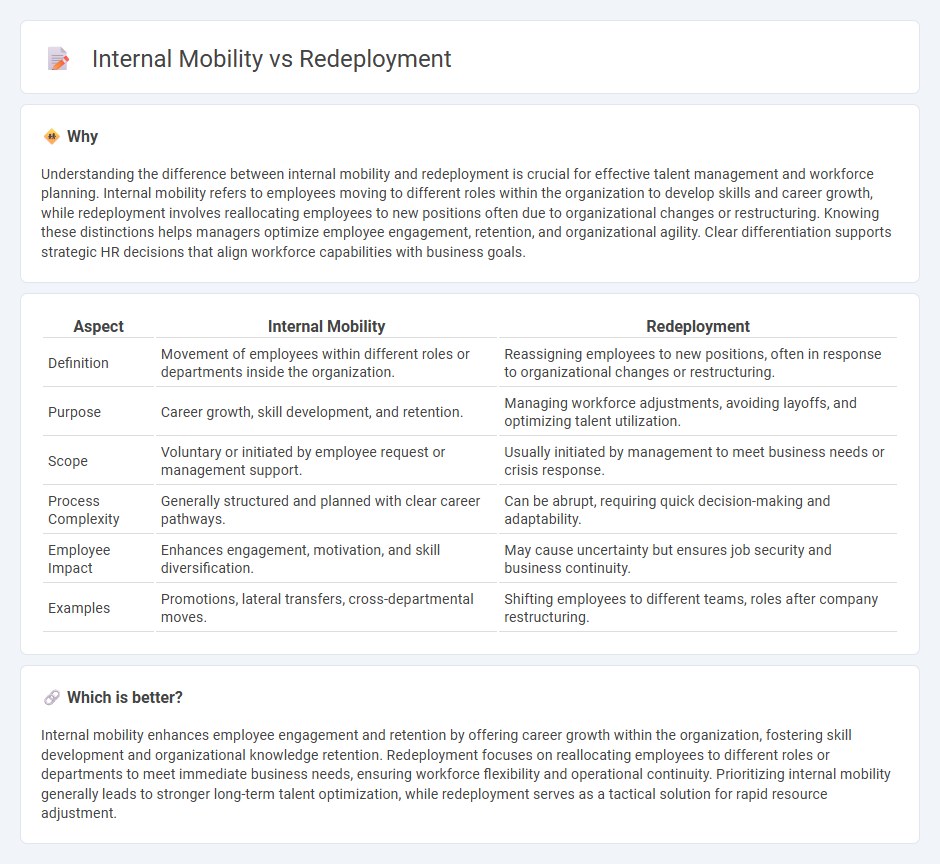
Internal mobility empowers organizations to retain talent by promoting employee growth within existing roles or departments, enhancing job satisfaction and reducing turnover rates. Redeployment focuses on strategically reallocating employees to different positions or locations to meet evolving business needs and optimize workforce utilization. Discover how leveraging both internal mobility and redeployment can drive efficient talent management and organizational agility.
Why it is important
Understanding the difference between internal mobility and redeployment is crucial for effective talent management and workforce planning. Internal mobility refers to employees moving to different roles within the organization to develop skills and career growth, while redeployment involves reallocating employees to new positions often due to organizational changes or restructuring. Knowing these distinctions helps managers optimize employee engagement, retention, and organizational agility. Clear differentiation supports strategic HR decisions that align workforce capabilities with business goals.
Comparison Table
| Aspect | Internal Mobility | Redeployment |
|---|---|---|
| Definition | Movement of employees within different roles or departments inside the organization. | Reassigning employees to new positions, often in response to organizational changes or restructuring. |
| Purpose | Career growth, skill development, and retention. | Managing workforce adjustments, avoiding layoffs, and optimizing talent utilization. |
| Scope | Voluntary or initiated by employee request or management support. | Usually initiated by management to meet business needs or crisis response. |
| Process Complexity | Generally structured and planned with clear career pathways. | Can be abrupt, requiring quick decision-making and adaptability. |
| Employee Impact | Enhances engagement, motivation, and skill diversification. | May cause uncertainty but ensures job security and business continuity. |
| Examples | Promotions, lateral transfers, cross-departmental moves. | Shifting employees to different teams, roles after company restructuring. |
Which is better?
Internal mobility enhances employee engagement and retention by offering career growth within the organization, fostering skill development and organizational knowledge retention. Redeployment focuses on reallocating employees to different roles or departments to meet immediate business needs, ensuring workforce flexibility and operational continuity. Prioritizing internal mobility generally leads to stronger long-term talent optimization, while redeployment serves as a tactical solution for rapid resource adjustment.
Connection
Internal mobility enhances talent retention by enabling employees to transition into new roles within the organization, reducing recruitment costs and preserving institutional knowledge. Redeployment acts as a strategic tool for management to realign workforce skills with evolving business needs while minimizing layoffs. Both practices foster a flexible, agile workforce that supports continuous organizational growth and adaptability.
Key Terms
Workforce Planning
Redeployment involves reallocating existing employees to different roles within an organization to meet changing business needs, while internal mobility encompasses a broader range of employee movements, including promotions, lateral moves, and transfers. Effective workforce planning integrates both redeployment and internal mobility strategies to optimize talent utilization, reduce hiring costs, and enhance employee engagement. Explore how these practices can transform your workforce planning approach for better organizational agility.
Talent Retention
Redeployment involves reallocating existing employees to different roles within the organization to match their skills with business needs, enhancing employee engagement and reducing turnover. Internal mobility, encompassing promotions, lateral moves, and cross-functional shifts, supports career development and strengthens talent retention by offering growth opportunities. Explore how strategic redeployment and internal mobility programs can maximize workforce potential and retain top talent.
Skill Utilization
Redeployment emphasizes reallocating employees to different roles within the organization to maximize existing skill sets and reduce layoffs. Internal mobility promotes career growth by enabling employees to transition across departments, fostering skill diversification and long-term engagement. Explore how strategic skill utilization through redeployment and internal mobility can enhance workforce agility and retention.
Source and External Links
Redeployment: A Guide for HR Managers & Employers - Personio - Redeployment is when an employer moves an employee from one role to another, often as a strategy to avoid redundancies, typically involving a formal process of identifying at-risk employees, offering alternative roles, a trial period, and final confirmation.
Redeployment: Overview, definition, and example - Cobrief - Redeployment is the process of reassigning employees or resources within an organization to different roles, departments, or locations, primarily to align personnel with changing business needs and to minimize layoffs during restructuring or shifts in demand.
What Is Redeployment? - Staffing Network - Redeployment involves moving employees internally from one job to another, helping organizations fill vacancies, reduce recruitment costs, and adapt staff to new roles while supporting them with training during the transition.
 dowidth.com
dowidth.com